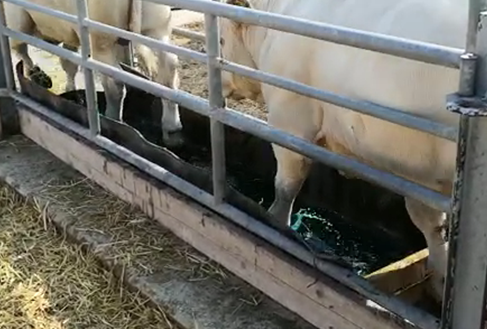Claw diseases (infectious or non-infectious) are a multifactorial problem from which there is no 100% protection. Predisposing factors for (infectious) hoof diseases are mainly farm environmental hygiene conditions and climate. Contamination of the hooves due to insufficiently drained and scraped corridors and poor quality of bedding material contribute to the development of hoof diseases, as moisture does. Especially in temperate climate, increasing humidity in winter is a problem and can be an indirect factor for non-infectious lesions by weakening the horn (Sogstad et al., 2005; Sanders et al., 2009; Magrin et al., 2018). Other predisposing factors are feeding (water-soluble carbohydrate content in the diet (WSC), NDF content in the feed) and the flooring in the barn (concrete or litter) (Magrin et al., 2020). It is not always possible to control all these parameters. An Italian farmer developed the system shown in the video for prevention and treatment of the animals.
 Click on the picture to start the video.
Click on the picture to start the video.This good practice is a simple and safe way to treat or prevent infectious claw diseases. For this purpose, disinfection troughs were installed in an existing handling facility. The aim was to ensure that all animals walk with all feet in the liquid solution. The design offers safety for the user and can be realized without high investment costs. During construction, care must be taken to ensure that the tube does not frighten the animals. Furthermore, it should be noted that the medication for the treatment is expensive and that a larger quantity is used for this system than for an individual treatment.
Good results can be achieved with a simple tool!
Literature:
- Brscic, M. et al. (2015): Synthetic rubber surface as an alternative to concrete to improve welfare and performance of finishing beef cattle reared on fully slatted flooring https://doi.org/10.1017/S1751731115000592
- Magrin, L. et al. (2019): Health, behaviour and growth performance of Charolais and Limousin bulls fattened on different types of flooring https://doi.org/10.1017/S175173111900106X
- Magrin, L. et al. (2018): An overview of claw disorders at slaughter in finishing beef cattle reared in intensive indoor systems through a cross-sectional study https://doi.org/10.1016/j.prevetmed.2018.10.018
- Magrin L. et a. (2020): Risk factors for claw disorders in intensively finished Charolais beef cattle https://doi.org/10.1016/j.prevetmed.2019.104864
This Good Practice has an Impact on:
- Animal health and welfare: Prevention and treatment of the animals and potential reduction of veterinary costs and of medicines use
- Production efficiency and Meat quality: The improvement of animal health and welfare could increase growth performance and production efficiency
In terms of infectious claw disorders there are some more texts on the BovINE Knowledge Hub:
Digital dermatitis: An expert vision of foot pathology
Preventing digital dermatitis
Prevention of Digital Dermatitis in housed beef cattle